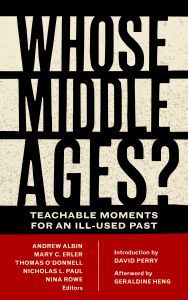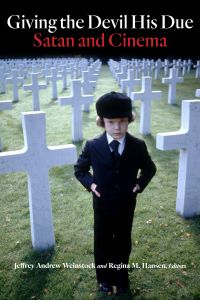Save 25% plus free shipping during our Winter Sale! Use promo code JOY2025. Expires 1/5/26.
Law, Justice, and Society in the Medieval World
An Introduction through Film

This book can be opened with

This coursebook is the first full-length study of cinematic “legal medievalism,” or the modern interpretation of medieval law in film and popular culture
For more than a century, filmmakers have used the “Middle Ages” to produce popular entertainment and comment on contemporary issues. Each of the twenty chapters in Law, Justice, and Society in the Medieval World represents an original contribution to our understanding of how medieval regulations, laws, and customs have been depicted in film. It offers a window into the “rules” of medieval society through the lens of popular culture.
This book includes analyses of recent and older films, avant-garde as well as popular cinema. Films discussed in this book include Braveheart (1995), Kingdom of Heaven (2005), The Passion of Joan of Arc (1928), The Last Duel (2021), The Green Knight (2021), The Little Hours (2017), and The Adventures of Robin Hood (1938), among others.
Each chapter explores the contemporary context of the film in question, the medieval literary or historical milieu the film references, and the lessons the film can teach us about the medieval world. Attached to each chapter is an appendix of medieval documentary sources and reading questions to prompt critical reflection.
This book is a lively and erudite collection of essays addressing the complex relationship between the Middle Ages and their cinematic representation since the beginning of the twentieth century. Certain of the films are well known, classics even; others have fallen into obscurity over the years, but all of them under the skillful scrutiny of the scholars represented in the collection testify powerfully to the benefits—and dangers—of mobilizing imagined medieval histories in the cultural and ideological controversies of modernity.—William Chester Jordan, Princeton University
These diverse and penetrating essays on medieval films show us the Middle Ages as a collection of legal communities. Legal documents and narratives of justice vividly recreate the lives of everyday medieval people, focusing intimately on their courtroom trials, codes of conduct and religious practices. A powerful teaching tool for a variety of medieval courses.—William F. Woods, MV Hughes Professor of English, emeritus, Wichita State University, and author of Chaucerian Spaces: Spatial Poetics in Chaucer's Opening Tales
Law, Justice, and Society in the Medieval World is a sophisticated and accessible collection of essays that puts medieval history and medievalist films into productive conversation with each other. It will be an excellent resource for anyone who wants to better understand the historical contexts for medievalist films and as a model for how to take medievalist film seriously as part of the ongoing project of better understanding medieval history and its reception. The essays are engaging, the variety of topics is excellent and timely without feeling trendy, and the appendices provide the concrete and complex historical context we all need in order to avoid oversimplifying the medieval world.—Usha Vishnuvajjala, author of Feminist Medievalisms: Embodiment and Vulnerability in Literature and Film
This groundbreaking collection is designed to support the teaching of medieval history through film. Its twenty highly accessible chapters concern a century’s worth of medievalist films (produced 1928 – 2021) set all over Europe, North Africa, and the Middle East, addressing both the contemporary contexts of the films and the medieval milieux that the films reference. Appended to each chapter are relevant medieval sources and reading questions. Aimed at instructors utilizing medievalist films to teach both the realities of the period and the dynamics of cinematic representation to undergraduates, the collection doesn’t so much fill a gap as create a new paradigm.—Felice Lifshitz, author of Reading Gender: Studies in Medieval Manuscripts and Medievalist Films
A wonderful resource for lovers of medieval history and cinema alike, this book offers analysis of the last century of film and its representation of legal practice and ideals of justice in medieval Europe. Each chapter offers incisive analysis of a particular film, coupled with a relevant primary source and questions for further thought. The result is an illuminating meditation on the relationship between medieval history and the various contexts and sensibilities that shape its modern portrayal. This book is not only for educators, medieval scholars, and students of history, it is also for all of those who watch a film and then wonder... Is that really how it was?—Ada Maria Kuskowski, Associate Professor at University of Pennsylvania and author of Vernacular Law: Writing and the Reinvention of Customary Law in Medieval France
What a refreshing and lively collection of essays! Each one invites us to read film as an interpretive genre that, like traditional historiography, responds to shifts in our understanding of the Middle Ages. Analyzing medieval law and justice through the lens of global film inspires readers to see these fields anew and rethink the place of art in historical inquiry.—Kristina Richardson, Professor of History and Midde Eastern & South Asian Languages and Cultures, University of Virginia
Esther Liberman Cuenca is Assistant Professor of History at the University of Houston- Victoria. She is the author of The Making of Urban Customary Law in Medieval and Reformation England. Her essays have appeared in Urban History, The Paris Review, Historical Reflections, Popular Music, and Continuity and Change.
M. Christina Bruno (Edited By)
M. Christina Bruno is Associate Director of the Center for Medieval Studies at Fordham University in New York. She is a historian of late medieval Italy, focusing upon fifteenth-century Italian Observant Franciscans as legal and economic experts and practitioners.
Anthony Perron (Edited By)
Anthony Perron is Associate Professor of History at Loyola Marymount University in Los Angeles. He is the author of three chapters in the Cambridge Histories series, including the Cambridge History of Medieval Canon Law. He has published articles in The Catholic Historical Review, The Journal of the Historical Society, and Historical Reflections, as well as in several edited volumes.
Introduction
Esther Liberman Cuenca, M. Christina Bruno, and Anthony Perron | 1
Canon Law and the World of the Medieval Church
1. Between Royal Law and Canon Law in Becket (1964)
Anthony Perron | 9
2. Relic Movement, Anathema, and Crusade in Pilgrimage (2017)
Sarah C. Luginbill | 22
3. The Creation of the Franciscan Rule in Francesco (1989)
Nathan Melson | 36
4. Poverty and Heresy in The Name of the Rose (1986)
M. Christina Bruno | 49
5. Joan of Arc’s Inquisitorial Trial of Faith in The Passion of Joan of Arc (1928)
Henry Ansgar Kelly | 61
“Feudal” Law and the Customs of Lordship
6. The Chivalric Code in The Green Knight (2021)
Coral Lumbley | 75
7. Crusading and Oath-Taking in Kingdom of Heaven (2005)
Esther Liberman Cuenca | 89
8. Forest Law in The Adventures of Robin Hood (1938)
Casey Ireland | 101
9. Trial by Battle and Gendered Medievalisms in The Last Duel (2021)
Sara McDougall and David M. Perry | 114
10. Animal Trials in The Advocate (1993)
Julie K. Chamberlin | 126
Women and Representations of Premodern Law
11. Religious Women’s Authority and Rules for Nuns in Vision:
From the Life of Hildegard von Bingen (2009)
Lucy C. Barnhouse | 141
12. War, Family, and the Law of the Kyivan Rus in Alexander Nevsky (1938)
Asif A. Siddiqi | 153
13. Church Law, Community Practice, and the Witch Trial That Wasn’t in Sorceress (1987)
Rachel Ellen Clark and Lucy C. Barnhouse | 166
14. The Myth of Jus Primae Noctis, or the “Right of the First Night,” in Braveheart (1995)
Lorraine Kochanske Stock | 180
15. Medieval Satire and the Canon Law of Claustration in The Little Hours (2017)
Spencer Strub | 195
Religious Conflict and Forging Communities through Law
16. Late Roman Law, Women’s Status, and Classical Education in Agora (2009)
Christopher Bonura | 211
17. Depicting the Prophet, Social Justice, and the Pillars of Islam in The Message (1976)
Maria Americo | 225
18. Lawful Language and Global North Encounters in The 13th Warrior (1999)
Daniel Armenti and Nahir I. Otaño Gracia | 237
19. Jewish Assimilation and the Absent “Saracens” and Africans of Ivanhoe (1952)
Celia Chazelle | 251
20. Medieval Science, the Spanish Inquisition, and Religious Violence in 1492:
Conquest of Paradise (1992)
Eugene Smelyansky | 265
Acknowledgments | 279
Contributors | 281
Index | 283




